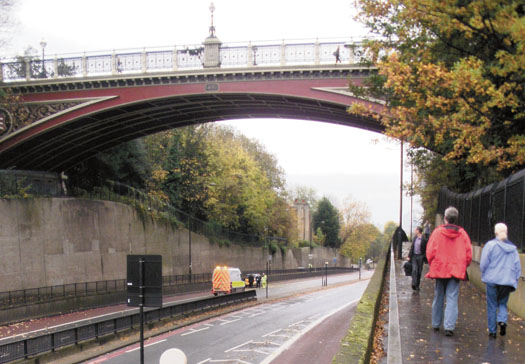Studies show that fitting bridge barriers cuts suicides
Friday, 14th July 2017

Archway Bridge
• NO one would lightly call for changes to the appearance of a historic Victorian bridge unless there was an overwhelming and life-saving case for the changes (An anti-suicide fence at Archway Bridge won’t stop people determined to die, July 7).
Andrew Crawford does not show evidence for the claims he makes, while he claims there is no scientific research on whether fencing helps prevent suicide.
In fact, scientific research (published in scientific papers so it is peer-reviewed by other scientists) shows that making suicide difficult or impossible does not simply divert those potential victims to places where they can end their lives.
There is often ambivalence about dying (the desire for the end of emotional pain, not for the end of life itself), and many who are prevented from dying are enormously grateful for the second chance of life.
British research from as far as 2007 in the much-respected British Journal of Psychiatry studied the effects of new anti-suicide barriers at Clifton Suspension Bridge. Part of its summary states: “Although 90 per cent of the suicides from the bridge were by males, there was no evidence of an increase in male suicide by jumping from other sites in the Bristol area after the erection of the barriers.
“This study provides evidence for the effectiveness of barriers on bridges in preventing site-specific suicides and suicides by jumping overall in the surrounding area.” (British Journal of Psychiatry, February 2007).
As is necessarily the case with articles in academic journals the issue is, of course, complex but other studies also indicate the same result – there is a statistically significant reduction in suicides after the introduction of physical barriers (including fences at bridges), and an overall reduction in suicide rates after these interventions.
There is no significant displacement of suicides to nearby sites. There is research-based evidence in favour of fencing as a measure for suicide prevention. Consistent with this research, the removal of barriers has been found to increase deaths by suicide.
Regarding the Clifton bridge, the study reports that the number of deaths halved after installation of the barriers. Combined with surveillance, these allowed intervention that saved lives. There was no evidence of displacement.
While waiting for physical changes to Archway Bridge, campaigners have supported all sorts of other measures. Islington Council has had regular liaison with the Samaritans (there have been signs on the bridge giving the Samaritans number) and there has apparently been positive results in decreasing suicide on the bridge since Islington was able to install CCTV cameras last year to spot people “dithering” on the bridge.
The proposed anti-suicide fence should not prevent vital dialogue with emergency services “talking down” potential suicide victims.
Sadly, Googling “suicide bridge” takes the surfer immediately to Archway Bridge. Until there are successful physical anti-suicide measures, this situation is a local disgrace.
Now is not the time to “blame” councils or other public bodies. Transport for London is charged with setting up anti-suicide measures. The process is difficult (they have to be tailor-made for the situation to be effective) but it is underway, and the sooner they are in place the better for all concerned.
CLLR DAVID POYSER
Hillrise ward
PROFESSOR DAVID MOSSE
Chair, Haringey Suicide Prevention Group
DR RACHEL GIBBONS
Psychiatrist,
Barnet, Enfield and Haringey Mental Health Trust